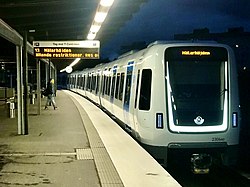| Alstom Movia | |
|---|---|
 | |
| Stock type | Electric multiple unit |
| In service | 1998–present |
| Manufacturer | Bombardier Transportation, Alstom (2021–) [1] |
| Designer | Adtranz |
| Family name | Movia |
| Constructed | 1997–present |
| Successor | Alstom Metropolis |
| Specifications | |
| Traction system | IGBT– or SiC–VVVF |
| Traction motors | 3-phase AC induction motor or permanent-magnet synchronous motor |
| Electric system(s) |
|
| Current collection |
|
| Bogies | [2] |
| Track gauge |
|
The Alstom Movia (introduced as the Adtranz Movia and later sold as the Bombardier Movia) is a family of metro train cars designed by Adtranz and later built by Bombardier Transportation and Alstom. The structure and body shell are fully customisable for the needs of each system that orders it. Unlike most traditional metro trains, they usually have full-width gangways between carriages, allowing passengers to walk the entire length of the train. The design was developed by Adtranz, which was acquired by Bombardier in 2001. Since Alstom's acquisition of Bombardier in 2021, Alstom will be responsible for construction and delivery of future Movia metro train cars. [1]
Contents
- Design
- Operators
- Canada
- China
- India
- Romania
- Singapore
- Sweden
- United Kingdom
- United States
- Production
- See also
- Notes
- References
- External links
Guangzhou Metro (Lines 1 and 8), Shanghai Metro (Line 9), and Shenzhen Metro (Line 1) all use Movia 456 trains, while Bucharest Metro (Line M1, M3, M5) use the Movia 346. Movia tube and sub-surface stock are in service on the London Underground (designated S Stock on the Circle, District, Hammersmith & City and Metropolitan lines and 2009 Stock on the Victoria line), Toronto subway (designated Toronto Rocket on Line 1 Yonge–University and Line 4 Sheppard), and Delhi Metro (Phase II only). Singapore MRT's North South and East West lines ordered 106 R151 Movia trains, one of the largest orders in Singapore.




